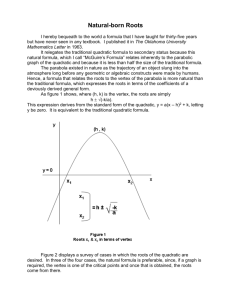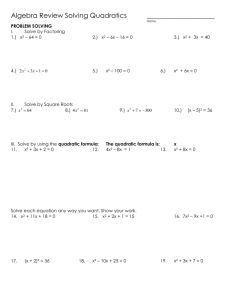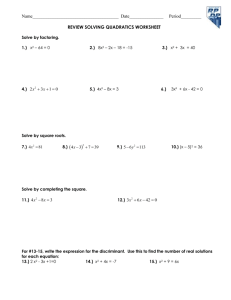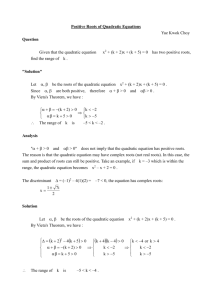Lesson 2 – Number of Solutions
advertisement
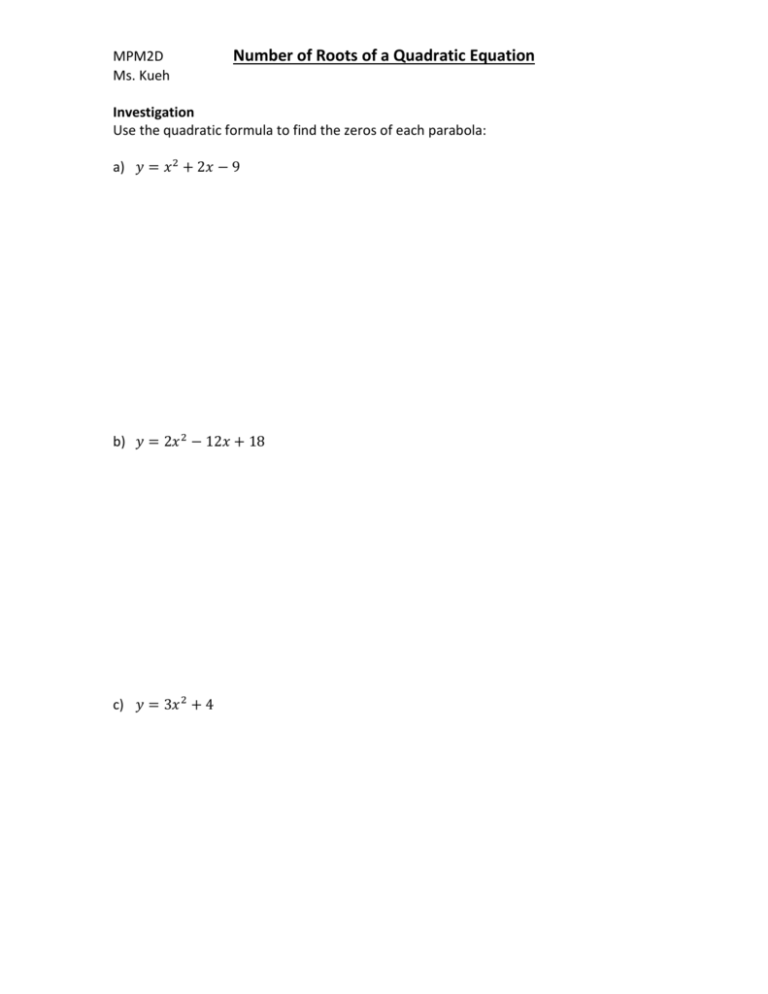
MPM2D Ms. Kueh Number of Roots of a Quadratic Equation Investigation Use the quadratic formula to find the zeros of each parabola: a) 𝑦 = 𝑥 2 + 2𝑥 − 9 b) 𝑦 = 2𝑥 2 − 12𝑥 + 18 c) 𝑦 = 3𝑥 2 + 4 1. Graph the following parabolas on the grid below using any method from the last unit. a) 𝑦 = 𝑥 2 + 2𝑥 − 9 b) 𝑦 = 2𝑥 2 − 12𝑥 + 18 c) 𝑦 = 3𝑥 2 + 4 Definition: __________________ is called the __________________________. It tells us how many roots a quadratic equation will have. If the _______________ is positive, there will be __________________. If the _______________ is zero, there will be _____________________. If the _______________ is negative, there will be _________________. Example 1 Determine the number of roots each equation 2 a) −5𝑥 + 8𝑥 − 10 = 0 b) 7𝑥 2 − 6 = 0 Example 2 Find the complex roots of: Homework: Worksheet 𝑦 = 𝑥 2 − 4𝑥 + 7 Discriminant and Quadratic Formula Worksheet 1. Determine how many real roots the equation has. a. 𝑥 2 + 9 = 0 b. 𝑥 2 + 5𝑥 − 8 = 0 c. 2𝑥 2 − 12 = 0 d. 3𝑥 2 + 2𝑥 + 6 = 0 e. 9𝑥 2 + 12𝑥 = −4 f. 𝑥 2 = −8𝑥 + 3 g. (𝑥 − 4)2 = 0 h. −3(𝑥 + 2)2 + 10 = 0 i. (𝑥 − 2)2 − 5 = 0 2. For g, h, and i there are 2 methods of finding the number of roots. Find the number of roots an alternate way. Which way required less work? 3. Find the roots of the equation by factoring. a. 𝑥 2 − 9 = 0 b. 𝑥 2 + 𝑥 − 6 = 0 c. 2𝑥 2 − 8𝑥 = 0 d. 2𝑥 2 + 𝑥 − 15 = 0 e. 3𝑥 2 − 75 = 0 4. Why is factoring preferable to using quadratic formula in question 3? 5. Find the roots of the equation, if possible. Use the most appropriate method. a. 𝑥 2 − 8𝑥 = −16 b. 2𝑥 2 + 3𝑥 − 20 = 0 c. (𝑥 − 5)2 = 16 Hint: move everything to the other side to isolate 𝑥 d. 𝑥 2 + 10 = 0 e. −2(𝑥 + 1)2 + 10 = 0 f. 𝑥 2 = 90 − 6𝑥 g. −5𝑥 2 + 15𝑥 = 11 h. 3.2𝑤 2 + 28.9𝑤 − 8.4 = 0 6. Determine the number and type of roots (real and distinct, real and equal, or complex) a. b. 𝑥2 2 +4𝑥 + 4 = 0 𝑥−1 2 −𝑥 2 − 3 = 0 c. (𝑥 + 1)(𝑥 − 2) = 4 d. 4(𝑥 2 − 5𝑥 + 5) = −5 TIPS Practice: 7. Determine the value(s) of 𝑘 that will give the indicated solution. a. 𝑥 2 − 4𝑥 + 𝑘 = 0 ; equal roots b. 𝑥 2 + 3𝑥 − 2𝑘 = 0 ; complex roots c. 𝑥 2 + 𝑘𝑥 + 16 = 0 ; real distinct roots 8. Find the value of 𝑘 such that the quadratic equation 𝑘𝑥 2 + (𝑘 + 8)𝑥 + 9 = 0 has equal roots. Answers: 1. a) none b) 2 c) 2 d) none e) 1 f) 2 2. Sketch the parabola, since it is in vertex form. If it is already in vertex form, it is usually less effort to just do a quick sketch. 3. a) 𝑥 = −3,3 b) 𝑥 = −3,2 c) 𝑥 = 0,4 5 d) 𝑥 = 2 , −3 e) 𝑥 = −5, 5 4. It is much faster, and less likely that you will make a mistake. 5. a) 4 e) 1.24, -3.24 b) 2.5, -4 c) 9, 1 f) 6.95, -12.95 g) 1.72, 1.28 h) 0.28, -9.31 6. a) real and distinct b) complex 7. a) 4 b)𝑘 < − 8 8. 4 or 16 9 c) real and distinct c) 𝑘 > 8 or 𝑘 < −8 d) no real roots d) real and equal

